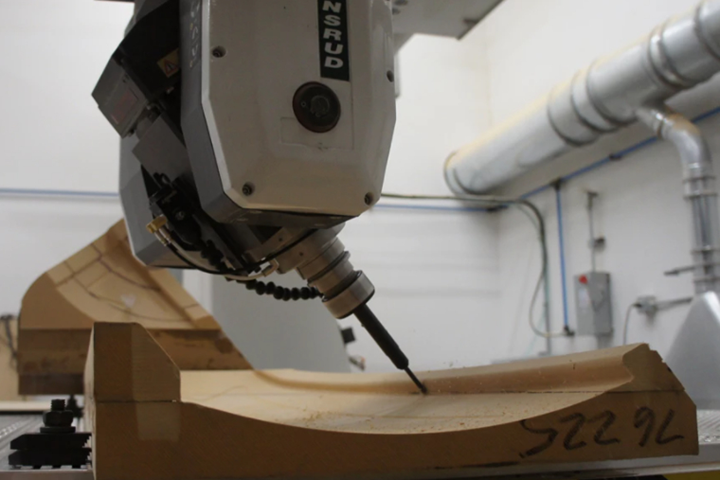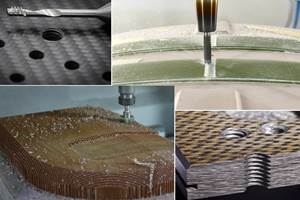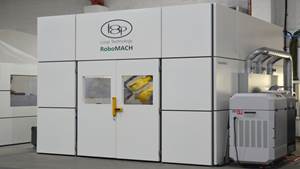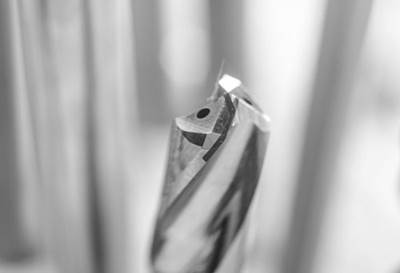
Machining of a part-seating undercut in a medium-density fiberboard fixture. Photo Credit: DeltaWing Manufacturing
Almost every composite part, regardless of its constituent materials and regardless of how it’s made, must go through a finishing process in a machining operation. Trimming, drilling and routing are just some of the operations that might be performed. However, composite materials in a machining environment behave differently than metals do and thus must be treated differently. Further, like any other manufacturing process, there is a need for continuous optimization of machining. The eight following tips will help you machine composite materials and remove inefficiencies in the process.
1. Know your constituents
Before getting into the manufacturing process, let's understand the constituents of composite materials. These constituents are further divided into two groups:
- Matrices
- Reinforcements
FRP (fiber-reinforced plastic) composites are produced from strands of aramid, carbon, glass or other fibrous synthetics. These reinforcements are bound together using some resin, typically a thermoset or thermoplastic system.
You can also use added ceramic or metal powders as reinforcements. Other additives like silica or silicon dioxide can also enhance the properties of composite materials.
2. Dust removal
The removal of dust is vital to ensure the streamlined machining of composite materials and safeguard the workers' health. Fiberglass, for example, produces a staggering amount of harmful dust during the composite machining process. Besides, dust particles are severely damaging to machine controllers as well as equipment. Most aircraft manufacturers cannot let debris be trapped inside structures and require efficient dust removal methods.
Alternatively, carbon fiber dust is perilous to electronic devices because it is electrically conductive. If this dust level goes unchecked, it can short out machine circuits and cause digital devices to go haywire. Carbon fiber dust can also lead to lung damage.
To keep these particulates from barraging the workstation, install a suitable cartridge-style dust collector. You must also be sure to seal the machine tool enclosure if possible.
3. Proper cutting tool selection
Considering the abrasive nature of composites, high-speed steel and even cemented carbide cutting tools are quick to fail. Indexable milling cutters and turning tools with polycrystalline diamond (PCD) tips are twice as expensive as carbide tools. Nonetheless, they take the lead in tool life and machine uptime and render a high-quality surface finish during machining. This is especially true for carbon fiber-reinforced polymers (CFRP), which require the use of competent cutting tools often for complicated tool geometries.
4. Keep the tools sharp
Sharp tools are paramount when machining composite materials. Intricately designed compressive helix cutters reduce delamination and hanging (uncut fibers) during trimming. Endmills are efficient for orthogonal cutting, including slotting, trimming and pocketing. For holemaking, diamond drills with specific edge chamfers, radii and a modified brad point help limit delamination or splintering during the process of breaking through.
5. Massive rpms and necessary parameters
Cutting speed and feed affect the final surface finish of a component, as well as the power requirements, and the material removal rate of a CNC machine. Because of this, it is imperative to consider the type of composite material to be machined, rigidity of the workpiece, the size and condition of the lathe and depth of cut.
Cutting speeds of 550 to 760 meters per minute or greater are ideal for such materials, with starting feed rates of 0.076 millimeters per tooth for a 6.3-millimeter two-flute cutter, a whopping 30,000 rpm and 4.570-millimeter-per-minute feed.
It is also imperative to adjust speeds and feeds to avoid melting the resin. Because of this, you must lock feeds at 0.001 inches per tooth (ipt) or greater for larger diameters. Speeds must be maintained at 400-500 surface feet per minute (sfm), as this works for most material types.
If you are machining solid composites, bring the spindle speed down to one-third of those values; you can also go through the cutting tool provider to learn about proper parameters.
6. Pick the right tool holder
High-quality diamond and diamond-coated cutting tools lead to successful CFRP machining operations. But they might not yield decent results without the right tool holder for a firm grip.
Hydraulic chucks help mitigate run-out and the possibility of tool pullout, either of which can be hazardous when plowing through an expensive aerospace structure.
When operating at higher spindle speeds — more than 20,000 rpm — it is advisable to have the tool holders balanced as a complete assembly, ensuring that the cutting tool and retention knob are installed.
7. Pick the right angle of attack and geometry
Because composites feature a fiber-based reinforcement, they can pose unprecedented challenges to machinists. The abrasive nature of composites leads to shorter tool life. Dull tools, in turn, lead to delamination and hanging fibers.
With the right cutter, some of these challenges can be avoided. Still, machinists should learn to read the wear patterns on cutting tools and tweak tool paths. Milling climb cutting might not always yield better results than conventional cutting. Switching to a brad point can help prevent delamination on the backside of a hole.
8. Ensure proper cooling
Applying coolant can help lubricate tools and discharge heat and dust from the work environment. Lubricants can be used with composites. However, the lubricant can mix with the fiber/resin dust to create an abrasive paste that is difficult to tackle. Also, composites can absorb water and swell. To counter this, opt for a cold air gun. A cold air gun is very efficient at cooling the workplace and helps remove debris. However, you must capture the tornado of composite dust with an appropriately sized dust collection system.
Installing high-tech solutions such as cryogenic cooling systems might be out of reach for most companies. Still, if you can afford them, they provide the best cooling system for machining.
The optimum methodology to machining composites
Composites are the most challenging materials a machinist will encounter. They are dusty, laborious and abrasive and rough on tools.
You should pick the right combination of cutting-edge geometry and tool material. Be sure to get the right cutting tools and tool holders, prevent dust from entering the workplace and think outside the box to devise innovative solutions.
About the Author
Peter Jacobs
Peter Jacobs is the senior director of marketing at CNC Masters. He is actively involved in manufacturing processes and regularly contributes his insights for various blogs in CNC machining, 3D printing, rapid tooling, injection molding, metal casting and manufacturing in general.
Related Content
Plant tour: Joby Aviation, Marina, Calif., U.S.
As the advanced air mobility market begins to take shape, market leader Joby Aviation works to industrialize composites manufacturing for its first-generation, composites-intensive, all-electric air taxi.
Read MoreOptimizing machining for composites: Tool designs, processes and Industry 4.0 systems
Hufschmied moves beyond optimized milling and drilling tools to develop SonicShark inline quality control system and Cutting Edge World cloud platform for optimized tool use and processes.
Read MoreLoop Technology robotic machining system works with harder materials
The RoboMach HA is a high-accuracy robotic machining system that can work with a range of materials, including cured composites.
Read MoreFrom the CW Archives: Drilling is not for the faint of heart
This edition of From the CW Archives revisits CW’s first plant tour — a visit to the F-35 FAL in Fort Worth, Texas — and a story by Ginger Gardiner a few years later. Both offer lessons on how to perform stacked drilling through composite and metallic materials.
Read MoreRead Next
Searching for composites-friendly machine tools
This is IMTS week, where "composites" is a foreign word to much of the machine tool industry. It's not too hard, however, to find suppliers who know their way around composite structures.
Read MoreComposites end markets: Energy (2024)
Composites are used widely in oil/gas, wind and other renewable energy applications. Despite market challenges, growth potential and innovation for composites continue.
Read MoreFrom the CW Archives: The tale of the thermoplastic cryotank
In 2006, guest columnist Bob Hartunian related the story of his efforts two decades prior, while at McDonnell Douglas, to develop a thermoplastic composite crytank for hydrogen storage. He learned a lot of lessons.
Read More

















.jpg;maxWidth=300;quality=90)









.jpeg;maxWidth=300;quality=70)



